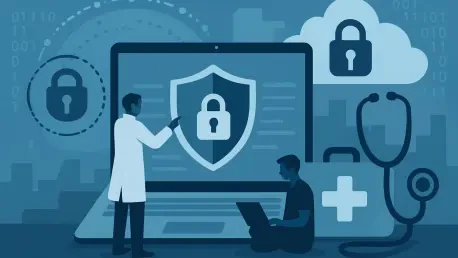In the rapidly shifting world of healthcare technology, a pressing and complex challenge has surfaced as cyber threats loom larger than ever, outstripping the impact of traditional disasters like earthquakes or electrical failures, which have long been the focus of contingency planning. These digital assaults, often in the form of ransomware, can silently infiltrate systems, paralyze operations, and jeopardize patient safety for extended periods, unlike the more predictable physical disruptions of the past. Healthcare organizations find themselves at a critical juncture, forced to overhaul outdated recovery frameworks to combat an enemy that operates in the shadows of their networks. This exploration delves into the stark differences between conventional disaster recovery and the emerging field of cyber recovery, drawing on real-world incidents and forward-thinking strategies to reveal how hospitals and health systems are adapting. With patient care hanging in the balance, the urgency to develop robust defenses against these invisible attacks has become a top priority for IT leaders across the sector.
Understanding the Recovery Divide
Healthcare has long relied on disaster recovery (DR) plans tailored for tangible crises such as natural calamities or infrastructure breakdowns, where the goal is a swift return to normalcy through backup systems and predefined protocols. Typically, these plans assume downtime measured in hours or, at most, a few days, with clear steps to restore servers and data from secure copies. However, cyber recovery addresses a far more insidious problem—threats like ransomware that encrypt critical data, steal sensitive information, and disrupt operations for weeks. Unlike physical disasters, these attacks often remain undetected until significant harm is done, leaving health systems scrambling to respond. The fundamental mismatch lies in the nature of the threat: traditional DR cannot account for the prolonged, pervasive impact of a digital breach that locks out entire networks. This discrepancy has pushed healthcare IT leaders to recognize that cyber incidents demand a distinct approach, one that goes beyond mere restoration to encompass sustained functionality under duress.
A striking example of this divide came to light with a devastating ransomware attack on a major health network in 2020, where over a thousand servers were incapacitated in mere minutes due to a single errant click on a malicious email link. Critical patient services, including specialized treatments like radiation therapy, were halted, exposing a harsh reality: standard DR protocols designed for short-term outages were woefully inadequate for the weeks-long paralysis induced by cyber threats. The incident revealed how swiftly a digital intrusion can escalate, far outpacing the timelines of floods or power cuts. More crucially, it highlighted the absence of contingency plans for extended system unavailability, forcing clinical staff to operate without access to vital electronic records. This real-world crisis serves as a sobering reminder that healthcare must pivot toward strategies that address the unique, drawn-out nature of cyber disruptions, ensuring that patient care isn’t derailed by an unseen adversary exploiting digital vulnerabilities.
Responding to Crisis with Innovation
When cyber threats strike, healthcare organizations often find themselves in uncharted territory, compelled to devise immediate solutions under immense pressure to maintain patient care. During the aforementioned 2020 ransomware incident, IT teams at the affected health network had to think on their feet, establishing isolated digital environments to support life-saving treatments while the primary systems remained offline. By implementing offline versions of their electronic health record (EHR) platform and resorting to printed patient data, clinicians could access essential information despite the lockdown of their main infrastructure. Though these makeshift measures were far from seamless, they proved vital in bridging the gap during a month-long outage of core systems. This scenario illustrates the critical need for adaptability in the face of cyber crises, where the inability to access digital tools for extended periods can directly threaten lives, pushing IT departments to innovate rapidly to keep operations afloat.
Beyond emergency responses, the aftermath of such attacks often sparks a deeper transformation in how healthcare systems fortify themselves against future threats. Post-recovery, the health network hit by the 2020 attack didn’t merely rebuild—it rearmed. Over 5,000 compromised devices were replaced, and advanced protective measures, including immutable backups and sophisticated endpoint detection tools, were integrated to prevent recurrence. This dual emphasis on restoration and defense underscores a pivotal shift in mindset: surviving a cyber incident isn’t enough; preparation for inevitable future assaults must begin immediately. The deployment of cutting-edge security solutions reflects an understanding that cyber recovery isn’t a one-time fix but an ongoing commitment to resilience. By learning from the chaos of a breach, healthcare entities can construct stronger digital fortifications, ensuring they’re better equipped to withstand the next wave of attacks while safeguarding the continuity of critical medical services.
Forging Resilience Through Preparation
Some healthcare systems refuse to wait for a cyber catastrophe to expose their weaknesses, instead taking proactive steps to build robust defenses well in advance. A leading health system in Houston exemplifies this approach by conducting regular ransomware simulations and adversarial drills that pit internal teams against each other to test monitoring and response capabilities. Since initiating these exercises years ago, the organization has meticulously charted how to sustain operations for up to a month without full network connectivity, engaging staff from clinical units to executive suites in the process. These simulations aren’t mere theoretical exercises; they map out real-world scenarios where IT systems could be inaccessible, ensuring that patient care protocols remain viable under extreme conditions. This forward-looking strategy, detailed through practical testing, demonstrates how preparation can transform potential vulnerabilities into manageable challenges, setting a benchmark for others in the industry.
The broader healthcare IT community echoes this call for preemptive action, with experts emphasizing that cyber threats often evade detection until substantial damage—such as data breaches—has already occurred. This delayed awareness necessitates a focus on prevention and early warning systems rather than relying solely on post-incident recovery. The Houston-based system’s integration of cyber resilience into its core operations reflects a growing industry trend: readiness must permeate every level of an organization, from technology to staff training. By anticipating prolonged disruptions and designing workflows to function without digital dependency for extended periods, healthcare providers can mitigate the impact of an attack before it even happens. This shift from reactive measures to strategic foresight highlights a consensus that enduring cyber threats requires not just technical solutions but a cultural commitment to vigilance and adaptability across all facets of patient care delivery.
Charting the Path Forward
Reflecting on the journey of healthcare IT through recent cyber challenges, it’s evident that the sector has grappled with unprecedented obstacles as digital threats outpaced traditional disaster scenarios. Health systems that endured brutal ransomware attacks learned hard lessons about the limitations of conventional recovery plans, adapting through innovative workarounds and sweeping security upgrades. Simultaneously, proactive organizations demonstrated the power of preparation, using simulations to harden their defenses against potential breaches. These experiences collectively reshaped the understanding of resilience in a digital age. Moving ahead, healthcare leaders must prioritize sustained investment in advanced security tools and regular training to anticipate cyber risks. Collaboration across institutions to share insights and tactics will be crucial, as will the development of flexible protocols that ensure patient care persists even under siege. By embracing these steps, the industry can transform past struggles into a foundation for a more secure future.









